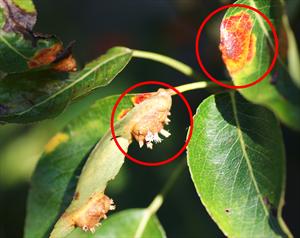Pear rust is a fungal disease affecting pear trees. The problem is easy to diagnose from the bright rusty-orange-red spots which appear on pear leaves in summer.
 Pear rust
Pear rustFungal rusts need a living host plant at all times in order to survive, so their life-cycles often involve two alternative host plants. In the case of pear rust, the alternative host will be nearby juniper or similar evergreen trees. (Evergreens do not lose their leaves so continue to nourish the fungal infection over the winter). During autumn, spores which have been released from growths on the underside of the pear leaves are blown to nearby juniper trees, where the fungal infection lives over the winter period.
In early summer spores are released from the juniper trees and re-infect nearby pear trees.
The photo shows (top right) the typical bright rusty-red appearance of the rust on the top surface of the leaf, and also (centre) the corresponding swelling on the underside of the leaf from which spores are released which will re-infect nearby juniper trees.
Pear varieties resistant to pear rust
Unfortunately there are no varieties which are resistant to pear rust.
Results of attack
Although pear rust looks dramatic and unsightly, the infection is not usually fatal to the tree.
Treatment
Rusts are quite easy to control if you can break the link with the alternate host, i.e. by removing all nearby juniper trees. However this is rarely possible.
The pear tree will probably survive the infection if it is otherwise strong and healthy. You can help it by keeping it fed and watered, and removing surrounding competing vegetation.
If the infection is light, remove all the infected leaves before the growths on the underside of the leaves mature and release their spores. This will prevent nearby juniper trees being re-infected, but this is not as reliable a method as removing the junipers. Do not try to remove leaves from a heavy infection as this will weaken the pear tree.
Some general-purpose fungicides may be available which will control pear rust.
